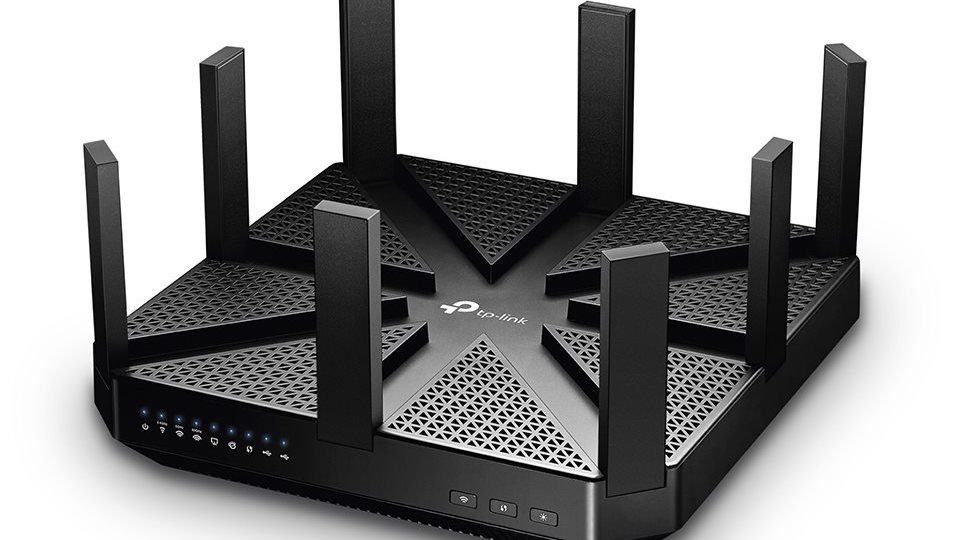TP-LINK offers 802.11ad router delivering 4.6 Gbps speeds in 60GHz band
Stream HD movies, play games and work across multiple devices

TP-LINK has launched an 802.11ad and 11ac Wi-Fi router for the home and workplace capable of providing throughput speeds of 4.6Gbps using the 60GHz band. The multi-band Talon AD7200 router is powered by the latest 802.11ad and 11ac MU-MIMO chipset solutions from Qualcomm Atheros².
In tests and typical daily usage trials this means that the new 60GHz band of spectrum added by the 802.11ad protocol means that users can achieve wireless transfer speeds of up to 4.6Gbps (three or more 1×1 MU-MIMO-enabled client devices must be connected to achieve faster performance). This is nearly three times the previous maximum transfer speed of 1.7Gbps achieved in the 5GHz band used by 802.11ac routers.
TP-LINK claimed that the Talon AD7200 will easily handle streaming 4K video from the cloud over a smart home or workspace Wi-Fi network. Additionally, for those that need a large number of smartphones, tablets, laptops and connected smart devices, then TP-LINK’s router delivers more bandwidth than most people will need.
For example, consumers can now download a feature-length 4K HD video in around four minutes or transfer 1,000 photos to a storage device in approximately five seconds, without any concerns about network interference.
The Talon AD7200’s MU-MIMO technology means bottlenecks caused by multiple devices all connecting at the same time can be avoided, which finally means that users can work, stream HD entertainment and play the latest PC or console games with no drop-offs in connectivity or performance.
The router features a unique eight antenna design, with high-powered amplifiers and dynamic beamforming technology to supercharge the Wi-Fi signal, so that all smart home, work and play devices remain connected to the network at all times.
Nelson Qiao, country manager at TP-LINK UK, said: “TP-LINK is committed to providing the most advanced connectivity to homes. With ultra-high speeds and increased network capacity, the Talon AD7200 Multi-band Wi-Fi Router will power the UK’s most bandwidth demanding households with ease.”
Are you a pro? Subscribe to our newsletter
Sign up to the TechRadar Pro newsletter to get all the top news, opinion, features and guidance your business needs to succeed!
Key features
• - AD7200 Multi-Band with 4-Stream Technology delivers up to 7200Mbps Wi-Fi speeds over 2.4GHz (800Mbps), 5GHz (1733Mbps), and 60GHZ (4600Mbps) bands*
• - 60GHz band allows users to stream 4K HD movies in minutes and instantly share thousands of files and photos over an interference-free connection
• - MU-MIMO Technology enables Wi-Fi for every device with multi-user support
• Powerful 1.4GHz dual-core CPU to enjoy high-speed connections without interruption
• - Active 60Ghz adaptive Beamforming enables Gigabit performance and dense deployment
• - Eight antennas with high-powered amplifiers supercharge your Wi-Fi signal
• - Four gigabit Ethernet ports enabling lightning-fast wired connections
• - Two USB 3.0 ports to share files, photos, music, and videos across the network
• - Beamforming Technology to send targeted Wi-Fi signals to individual devices
• - Set time limits and block websites through parental controls to keep children safe
• - Guest networks provide visitors with Wi-Fi access separate from your main network
• - Advanced security encryption to protect your data
• - Check network status and adjust Wi-Fi settings from your mobile device (Android, iOS) using the TP-LINK Tether App
• - Supports 802.11ad and backwards-compatible with 802.11a/b/g/n/ac.
The 802.11ad Wi-Fi standard
The IEEE 802.11ad Wi-Fi standard is designed to provide data throughput speeds of up to 7 Gbps using the 60 GHz ISM (industrial, scientific and medical) band to achieve the levels of bandwidth needed and ensure reduced interference levels.
Its range is limited to between 1m and 10m making it suitable for short range (across a room, for example) high volume data transfers such as HD video transfers. The standard is sometimes known as WiGig after the Wireless Gigabit Alliance (WGA) that promoted the solution.
The WGA worked with the IEEE to ensure the 802.11ad WiGig standard is compatible with previous Wi-Fi standards, so the WiGig MAC (medium-access-control) and PHY (physical layer) specification aligns exactly with the 802.11ad standard to enable seamless session switching between Wi-Fi networks operating in the 2.4 GHz, and 5 GHz bands with those using the 60 GHz WiGig bands.

Désiré has been musing and writing about technology during a career spanning four decades. He dabbled in website builders and web hosting when DHTML and frames were in vogue and started narrating about the impact of technology on society just before the start of the Y2K hysteria at the turn of the last millennium.